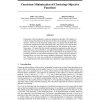Free Online Productivity Tools
i2Speak
i2Symbol
i2OCR
iTex2Img
iWeb2Print
iWeb2Shot
i2Type
iPdf2Split
iPdf2Merge
i2Bopomofo
i2Arabic
i2Style
i2Image
i2PDF
iLatex2Rtf
Sci2ools
NIPS
2007
2007
Consistent Minimization of Clustering Objective Functions
Clustering is often formulated as a discrete optimization problem. The objective is to find, among all partitions of the data set, the best one according to some quality measure. However, in the statistical setting where we assume that the finite data set has been sampled from some underlying space, the goal is not to find the best partition of the given sample, but to approximate the true partition of the underlying space. We argue that the discrete optimization approach usually does not achieve this goal. As an alternative, we suggest the paradigm of “nearest neighbor clustering”. Instead of selecting the best out of all partitions of the sample, it only considers partitions in some restricted function class. Using tools from statistical learning theory we prove that nearest neighbor clustering is statistically consistent. Moreover, its worst case complexity is polynomial by construction, and it can be implemented with small average case complexity using branch and bound.
Data Set | Discrete Optimization | Information Technology | Nearest Neighbor Clustering | NIPS 2007 |
| Added | 30 Oct 2010 |
| Updated | 30 Oct 2010 |
| Type | Conference |
| Year | 2007 |
| Where | NIPS |
| Authors | Ulrike von Luxburg, Sébastien Bubeck, Stefanie Jegelka, Michael Kaufmann |
Comments (0)

